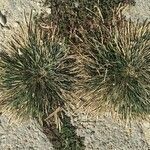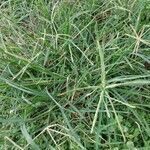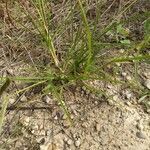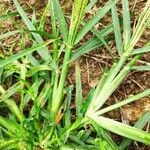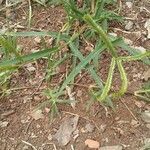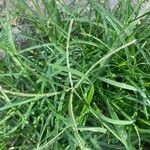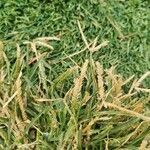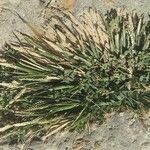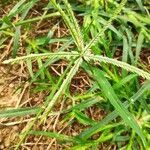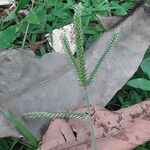Annual. Culms tufted, erect or geniculate at base, 10–90 cm tall. Leaf sheaths glabrous or tuberculate-pilose; leaf blades flat or folded, 10–15 × 0.3–0.5 cm, glabrous or adaxial surface tuberculate-pilose; ligule ca. 1 mm, membranous, at most sparsely ciliolate. Inflorescence digitate, racemes (1–)2–7, linear, ascending, 3–10 × 0.3–0.5 cm, one raceme often set below the rest. Spikelets elliptic, 4–7 mm, florets 3–9; glumes lanceolate, scabrid along keel; lower glume 1-veined, 1.5–2 mm; upper glume with small additional veins in the thickened keel, 2–3 mm; lemmas ovate, 2–4 mm, keel with small additional veins, acute; palea keels winged. Grain blackish, oblong or ovate, obliquely striate with fine close lines running vertically between the striae. Fl. and fr. Jun–Oct. 2n = 18.
Annuals or rarely perennials. Culms erect or prostrate or geniculate; flowering culms (15–) 40–90 (–100) cm high. Leaves: basal sheaths with margins pilose in the upper part; blade flat or folded, 5–40 cm long, 2.5–8 mm wide. Inflorescences subdigitate or digitate or rarely with whorled branches; branches 1–18, 3–15.5 cm long, 3–7 mm wide including the spikelets. Spikelets overlapping, 4–7.8 mm long, with 3–5 (–9) bisexual florets, disarticulating between the florets. Glumes unequal in length; lower glume 1.5–3.9 mm long; upper glume 2.4–4.3 mm long, acute. Basal lemma 3–4 mm long, muticous; keel winged; midnerve scaberulous. Palea keels winged. Grain enclosed by the lemma and palea, elliptic, obscurely trigonous or rounded in T.S., shallowly concave on hilar side.
Culms in tough spreading clumps, somewhat decumbent at the base, 15-70 cm., or rarely as much as 1 m., high, compressed, very smooth; sheaths compressed, sharply keeled, sparsely papillose near the margins toward the summit, otherwise glabrous, the margins hyaline; ligule membranaceous, erose, about 1 mm. long; blades as much as 25 cm. long, 2-8 mm. wide, flat or conduplicate, the tip navic-ular, glabrous or sparsely pilose on the upper surface, the margins scabrous; spikes 2 to several, 5-10 cm. long, stiffly ascending; spikelets 5 mm. long; lemmas 3 mm. long, broad at the base, rather abruptly narrowed to the subacute apex, sometimes mucronate.
Tufted annual 230-400 mm high; culm slender, often branching at the lower nodes. Leaf blade 50-350 x 2.5-6.0 mm; ligule a sparsely fringed membrane. Inflorescence subdigitate; racemes 1-14, 20-120 x 3.0-5.5 mm, slender. Spikelet 4-5 x 2-3 mm, 4-9-flowered; lower glume lanceolate to narrowly lanceolate-oblong, acute,1-nerved; upper glume 1.8-2.9 mm long, acute; lemma 2.1-3.6 mm long, lanceolate, apex acute to subacute, keel scabrid; palea keels scabrid along the wings; anther 0.6-1.1 mm long; caryopsis elliptic or lanceolate-elliptic, obliquely striate and with fine close lines perpendicular to the striae.
Tufted annual, 230-400 mm high; culm slender, often branching at lower nodes. Leaf blade 50-350 x 2.5-6.0 mm; ligule a fringed membrane. Inflorescence subdigitate; 1-14 racemes, 20-120 x 3.0-5.5 mm, slender. Spikelet 4-5 x 2-3 mm, awnless; lower glume lanceolate to narrowly lanceolate-oblong, acute, 1-nerved; upper glume 1.8-2.9 mm long, acute. Florets 4-9; lemma 2.1-3.6 mm long, apex acute to subacute, keel scabrid; palea keels scabrid along wings; anther 0.6-1.1 mm long. Flowering time Nov.-Feb. Caryopsis elliptic or lanceolate-elliptic, obliquely striate, with fine close lines perpendicular to striae.
A tufted annual grass. It grows up to 0.6 m tall. It has many branches from the base and tough wiry stems. The stems are slender and flattened. The leaves are 17 cm long and 3-8 mm wide. The leaves are covered with a bluish-green bloom. They are folded. The flower spikes are divided like fingers on a hand except for one which is single and below. The flowers do not have stalks and the flower spikes are 4-15 cm long. The seed heads shatter at maturity dropping their seed.
Culms 3–6 dm, branched from the base, spreading or ascending; sheaths papillose-ciliate distally; blades usually smooth; spikes usually 3–8, 4–10 cm × 5 mm, spreading or ascending; spikelets crowded, 3–6-fld; second glume 2–3 mm; lemmas 2.5–4 mm; 2n=18, 36. A common weed in lawns, gardens, and waste places; native of the Old World, now pantropical, extending n. to Mass., S.D., and Utah.
